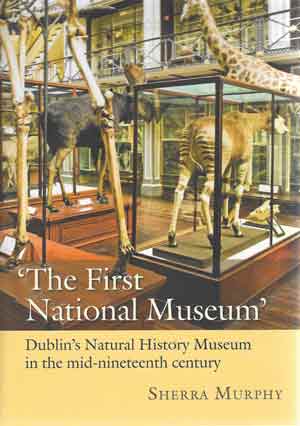‘THE FIRST NATIONAL MUSEUM’: Dublin’s Natural History Museum in the mid-nineteenth century
Published in Book Reviews, Book Reviews, Issue 4 (July/August 2022), Reviews, Volume 30SHERRA MURPHY
Cork University Press
€39
ISBN 9781782054559
Reviewed by Tony Canavan
Tony Canavan is Consultant Editor of Books Ireland.
Ireland’s Natural History Museum—or the ‘Dead Zoo’, as it is called in popular tradition—is well known to most Irish people, from school visits if nothing else. In this interesting book, Sherra Murphy traces the history of the museum from its origins in Irish learned societies to the mid-nineteenth century, when the Natural History Museum became a full-fledged national institution. It is a detailed study of a few crucial decades, which manages to take in the institutional and cultural antecedents of the museum as well as placing it in the context of developments elsewhere in the British Isles and Europe as a whole.
There were several learned societies in Ireland in the eighteenth and nineteenth centuries where ‘men of science’ studied, researched, wrote and collected specimens. Before hackles are raised at ‘men of science’, Murphy justifies her use of the term by saying ‘that Victorian intellectual culture, especially in the realm of science, was decidedly male-dominated’. Despite this, she does mention several women who were involved with the Natural History Museum, especially as donors of specimens.
These learned societies were part of a wider European movement that was questioning received wisdom about the world and seeking to understand its nature through discovery and analysis. People in Ireland were influenced by developments in France and Germany rather than Britain. In Ireland the leading institution in this area was the Royal Dublin Society (RDS), which sought to practically apply such knowledge in the interests of agriculture and industry. Acquiring specimens and displaying them for educational purposes was part of this and the origins of the museum.
In 1733 the RDS acquired the Leskean Collection, a cabinet of mineral specimens originally collected by Nathaniel Gottfried Leske, professor of natural history at the University of Leipzig. Over the years this collection was added to with specimens of minerals, fossils and animals until, in 1792, with the financial aid of the Irish parliament, the RDS created its first public display in its headquarters at Leinster House. Murphy points out that the British Museum in London and the Jardins des Plantes in Paris were the models that the RDS had in mind. The continuing evolution of the RDS’s museum reflected developments in scientific thinking not only in Ireland but throughout Europe. As humanity’s understanding of the world (and the universe) became based on empirical observation and analysis, natural history and science museums took a more professional approach, categorising objects properly and displaying them in a more organised manner. Incidentally, the invention of plate glass had a revolutionary impact on the design of display cabinets. Part of this was to see museums as a resource for the researcher and educational tool for the general public. Hence reference libraries were established, and regular public lectures given. An unintended offshoot of this was that museums became tourist attractions. By 1835, Dublin’s Natural History Museum was already listed as a ‘must see’ in guides to the city.
Murphy charts all this with a steady hand, chronicling the major developments in the museum’s history and highlighting the significant individuals involved, such as Alexander Carte, the first Irishman to be in charge and who was largely responsible for the professional approach to the conservation and display of the museum’s collection, which had grown considerably. By this time the museum had become a national institution under public control. The initiative for this came largely from the British parliament, where key interests lobbied for Ireland to have a scientific institution like those of Britain and Europe.
It was not until 1857 that the present home of the museum was built; even then, considerable rebuilding was done before it was opened to the public in 1869. In the following decades there were amalgamations of collections and stop/start progress, as the development of the museum was not a straightforward linear process. There were hitches along the way, as the influence of certain individuals waxed or waned, and priorities changed. It was to be some years before what we would recognise today as the Natural History Museum emerged.
Wisely, Murphy takes a thematic approach to the story of the ‘Dead Zoo’. Her book is divided into two sections, the first concentrating on the foundation and development of the museum, and the second on the museum’s role in the growth of scientific culture in Ireland. This does make it easier for the general reader to follow. She engages with the issues of where the artefacts in the museum originated (many from Irish people serving in the British Empire) and how approaches to natural history changed over the decades. This Irish museum never operated in isolation but was part of an international network of correspondence and exchange of information. Despite the book’s title, she takes the story up to the creation of an Irish state. The new authorities were more interested in the National Museum of Ireland, whose archaeological and historical artefacts were seen as playing a role in promoting the antiquity and legitimacy of the Irish nation. It was only relatively recently that central government diverted the necessary resources to enable the Natural History Museum to reach international standards in conservation, display and research. All in all, this is a comprehensive history of what can claim to be Ireland’s first national museum.

















